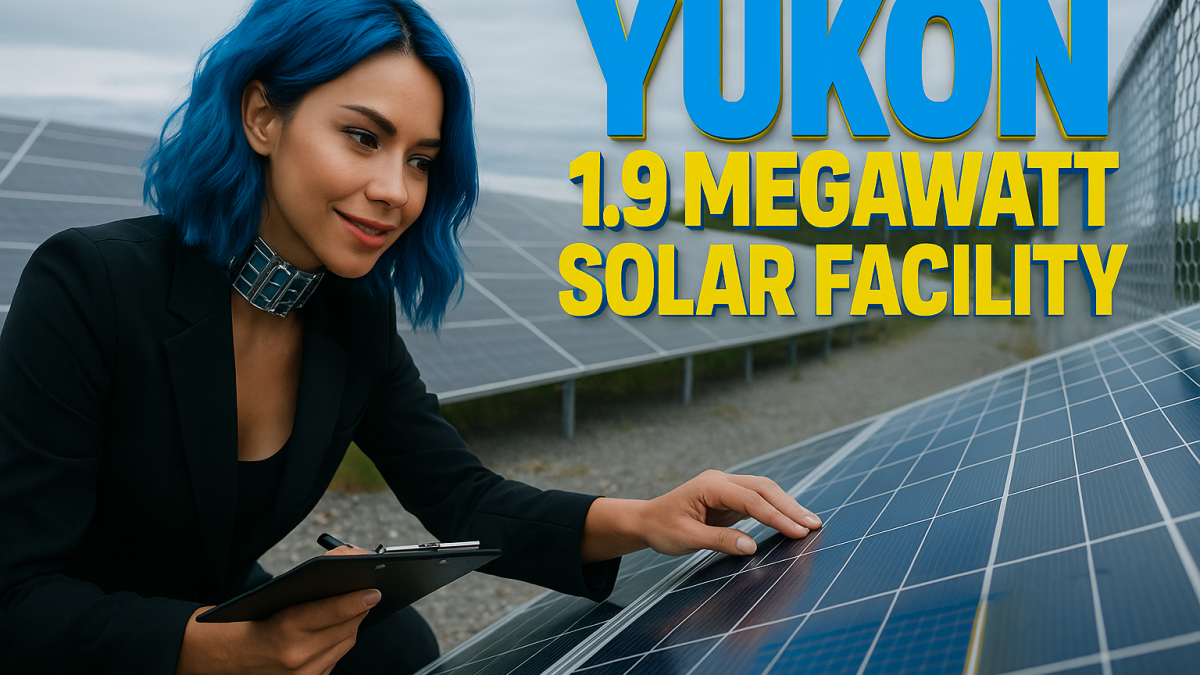
Solar Panels BC British Columbia Cost Installation Guide 2025
August 11, 2025
Installing and Selling Solar Panels In Canada: Jobs in Demand
August 18, 2025Today, I want to talk about a project that’s a genuine game-changer: the White River First Nation’s 1.9-megawatt (MW) Saa/Se Solar Project in Beaver Creek, Yukon.
it’s a blueprint for how remote communities can achieve energy independence and build a sustainable future. For years, the constant hum of diesel generators was the soundtrack to life in Beaver Creek. Now, there’s quiet. Since firing up on April 14, 2025, the solar farm has powered the community for up to 55 straight days without diesel.
Let’s break down how this impressive project came together—the money, the partners, the technology, and what it means for the rest of Canada.
The Core Challenge: Diesel Dependency in the North
To understand why this project is so important, you first need to understand the energy reality for many northern communities. Beaver Creek, a small community of about 110 people near the Alaskan border, has historically relied entirely on diesel generators for its electricity.
This has several major drawbacks:
- High Cost: Flying or trucking in fuel to remote locations is incredibly expensive, leading to high energy bills.
- Price Volatility: Global fuel prices can fluctuate wildly, making it impossible for communities to budget effectively.
- Environmental Impact: Diesel generators produce significant greenhouse gas emissions and local air and noise pollution.
- Reliability Issues: Supply chain disruptions, whether from weather or other factors, can threaten a community’s power supply.
The Saa/Se project was designed to tackle these problems head-on.
Project Breakdown: The Numbers and Tech
This is more than just a collection of solar panels. It’s a carefully engineered system designed for the harsh Yukon climate. The project was led by the White River First Nation’s development corporation, Copper Niisüü Limited Partnership.
Here are the key specifications:
| Component | Specification |
| Project Name | Saa/Se Solar Project (“Saa/Se” means “Sun” in Upper Tanana and Northern Tutchone) |
| Total Capacity | 1.9 megawatts (MW) |
| Solar Panels | 3,520 south-facing panels |
| Battery Storage | 3.5 megawatt-hours (MWh) Battery Energy Storage System (BESS) |
| Annual Diesel Displacement | Approximately 320,000 litres |
| GHG Reduction | An estimated 1,100 tonnes of CO₂ equivalent annually |
| Community Energy Supply | Expected to meet 55% of Beaver Creek’s annual electricity needs |
| Total Project Cost | $24 million |
| Operational Since | April 14, 2025 |
The secret sauce here is the Battery Energy Storage System (BESS). In my experience, simply adding solar to a grid isn’t enough, especially in a place with long winter nights. The batteries store excess solar power generated during the long summer days and discharge it at night or on cloudy days. This provides a stable, 24/7 power supply from the sun and gives the utility, ATCO, the confidence to shut the diesel generators completely off for long periods.
Who Built It? The Key Partners
A project of this scale doesn’t happen in a vacuum. It required a strong collaboration between several key organizations.
- Project Lead & Owner: Copper Niisüü Limited Partnership, the economic development arm of the White River First Nation (WRFN), spearheaded the project, ensuring it aligned with the community’s vision for self-reliance.
- Utility Partner: ATCO Electric Yukon played a crucial role. They entered into a 30-year Electricity Purchase Agreement (EPA). This is a critical piece. Under the EPA, the First Nation sells the solar power it generates to ATCO, creating a long-term, predictable revenue stream for the community. This is economic reconciliation in action.
- Engineering & Consulting: Firms like BBA and 3EYOND Consulting provided the technical expertise. They handled everything from the initial feasibility studies and design to helping negotiate the EPA and overseeing construction. Their work involved tackling unique northern challenges, like designing foundations for permafrost.
- Regulatory Approval: The Yukon Environmental and Socio-economic Assessment Board (YESAB) gave the project its approval back in 2020, ensuring it met the region’s environmental and social standards.
The Money: How a $24 Million Project Was Financed
So, where did the $24 million come from? This is the question I get most often from people looking to start large community projects. The funding for the Saa/Se project is a fantastic example of a multi-level government partnership to support Indigenous-led clean energy.
The bulk of the funding came from the Government of Canada, which committed a total of $15.5 million. This wasn’t from a single pot of money but was strategically combined from two key programs.
Here’s the federal funding breakdown:
| Federal Program | Amount | Department |
| Clean Energy for Rural and Remote Communities (CERRC) | ~$13.4 million | Natural Resources Canada (NRCan) |
| Inclusive Diversification and Economic Advancement in the North (IDEANorth) | $2 million | Canadian Northern Economic Development Agency (CanNor) |
| Total Federal Investment | ~$15.5 million | Government of Canada |
Export to Sheets
The strategic funding is what made the project viable. The CERRC program is specifically designed to help communities reduce their reliance on diesel, while IDEANorth focuses on economic development. Together, they provided the financial muscle to get the project off the ground.
The remaining $8.5 million of the project’s cost was covered by other sources, including the Government of Yukon. While the exact contribution from the territorial government isn’t specified in public documents, their partnership was essential.
Tip for Your Project: If you’re planning a community energy project, don’t look for a single grant to cover everything. The success of the Saa/Se project shows that combining funds from different federal and provincial/territorial programs with specific mandates (e.g., environment, economic development, Indigenous relations) is a powerful strategy.
A Timeline of Success
Big infrastructure projects take time and persistence. This wasn’t an overnight success.
- 2019: The journey begins with feasibility studies.
- 2020: YESAB gives the environmental and social green light.
- 2021: Early site preparation work starts.
- August 2022: The crucial $15.5 million federal investment is officially announced.
- 2023: Full-scale construction gets underway.
- April 14, 2025: The switch is flipped, and the facility starts delivering clean power.
- August 11, 2025: The community and partners hold a celebration to mark the official completion.
Why This Project is an Inspiration for Canada
The Saa/Se Solar Project is more than just a power plant. It represents a fundamental shift. For decades, the story of energy in the North was about dependence. This project flips the script to one of independence and ownership.
- Economic Sovereignty: The 30-year agreement with ATCO provides a stable income for the White River First Nation. This revenue can be reinvested into other community priorities, from housing to health and education. It’s a model for generating wealth and reducing reliance on federal funding.
- Energy Security: The community is no longer as vulnerable to diesel price shocks or supply issues. They now produce over half of their own power right at home.
- Environmental Leadership: Displacing 320,000 litres of diesel every year is a massive win for the environment. It proves that even in the challenging northern climate, renewable energy is not just possible, but practical.
- A Replicable Model: This project provides a clear, data-backed roadmap for other remote and Indigenous communities across Canada. It shows how to build the right partnerships, secure funding, and execute a complex project successfully.
I’ve seen many solar projects over the years, but this one stands out. It’s a story about community vision, smart partnerships, and the power of the sun to create a quieter, cleaner, and more prosperous future. It truly embodies the spirit of our slogan at SolarEnergies.ca: Canada goes Solar.
A documentary about the project is expected in 2026, and I for one will be tuning in to see this incredible story on screen.




